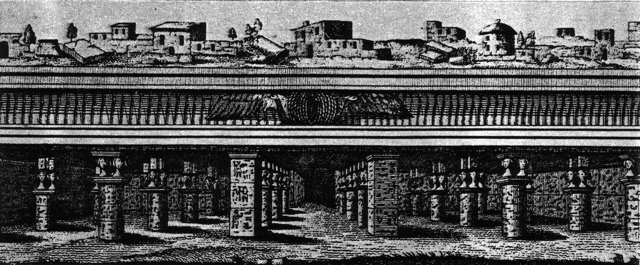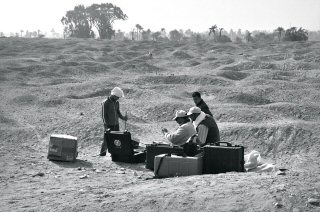|
Location: Hawara, Egypt. |
Grid Reference:
29.274� N,
30.901�
E. |
 The Great Labyrinth of Egypt:
(The 'lost Labyrinth').
The Great Labyrinth of Egypt:
(The 'lost Labyrinth').
 Scroll down for more:
This colossal temple was
described in the past by authors such as Herodotus and Strabo, and
was said to contain 3,000 rooms full of hieroglyphs and paintings.
Long thought of as another legend without foundation, it seems
that the building, lost for over 2000 years, has been recently
re-discovered.
 The
sand of Hawara was scanned Earlier this year (February-March 2008),
by a Belgian Egyptian expedition team in an effort to research the
'quarry theory' suggested by Petrie in 1889, following his finding
of a great artificial stone surface (304m by 244m). Petrie
interpreted the enormous artificial stone plateau he discovered at
the depth of several meters, as the foundation of the labyrinth,
concluding that the building itself was totally demolished, as a
stone quarry in the Ptolemaic period. However, the �foundation� un-penetrated by early expeditions, never lost the possibility of
being the roof of the Labyrinth, described by Strabo as a great
plain of stone. the following is from the official
report of the dig: The
sand of Hawara was scanned Earlier this year (February-March 2008),
by a Belgian Egyptian expedition team in an effort to research the
'quarry theory' suggested by Petrie in 1889, following his finding
of a great artificial stone surface (304m by 244m). Petrie
interpreted the enormous artificial stone plateau he discovered at
the depth of several meters, as the foundation of the labyrinth,
concluding that the building itself was totally demolished, as a
stone quarry in the Ptolemaic period. However, the �foundation� un-penetrated by early expeditions, never lost the possibility of
being the roof of the Labyrinth, described by Strabo as a great
plain of stone. the following is from the official
report of the dig:
Underneath
this upper zone, below the artificial stone surface appears (in
spite of the turbid effect of the groundwater) at the depth of 8
to 12 meters a grid structure of gigantic size made of a very
highly resistant material like granite stone. This states the
presence of a colossal archaeological feature below the labyrinth
�foundation� zone of Petrie, which has to be reconsidered as the
roof of the still existing labyrinth.
|
A geophysical survey of the area has revealed
the presence of 'vertical walls' under the stone surface at the
depth of 8 to 12 meters, connecting to form a gigantic grid
structure made of granite. The grid structure of the labyrinth is
offset 20� to 25� to the orientation of the nearby pyramid at
Hawara. It was written that an underground tunnel connected the
two structures.
|
Should this
discovery become substantiated as Herodotus famed 'Labyrinth',
(and the roof rather than the base), then it will rank alongside
other great discoveries of our times, and will become one of the
architectural jewels in Egypt's crown. Congratulations to Monsieur
de Cordier and all involved.
(Click here for the full Mataha report.)
|
Historic accounts:
The Egyptian Labyrinth was more than
1,300 years old at the time of Herodotus' visit
Herodotus, in Book II of his Histories, describes a "labyrinth"
complex in Egypt, "near the place called the City of Crocodiles",
that he considered to surpass the pyramids in its grandeur:
'It has twelve covered
courts � six in a row facing north, six south � the gates of
the one range exactly fronting the gates of the other. Inside,
the building is of two storeys and contains three thousand
rooms, of which half are underground, and the other half
directly above them. I was taken through the rooms in the
upper storey, so what I shall say of them is from my own
observation, but the underground ones I can speak of only from
report, because the Egyptians in charge refused to let me see
them, as they contain the tombs of the kings who built the
labyrinth, and also the tombs of the sacred crocodiles. The
upper rooms, on the contrary, I did actually see, and it is
hard to believe that they are the work of men; the baffling
and intricate passages from room to room and from court to
court were an endless wonder to me, as we passed from a
courtyard into rooms, from rooms into galleries, from
galleries into more rooms and thence into yet more courtyards.
The roof of every chamber, courtyard, and gallery is, like the
walls, of stone. The walls are covered with carved figures,
and each court is exquisitely built of white marble and
surrounded by a colonnade'.(1)
The 1st century BC Greek geographer Strabo is
the only other ancient eyewitness of the Egyptian Labyrinth
whose account has survived.
Strabo said of it
that it was "a great palace composed of many palaces" and
marvelled at enormity of the stone slabs that made up its roof
and walls. He wrote that it had many great courts, each with its
own entrance, but that "in front of the entrances are crypts, as
it were, which are long and numerous and have
winding passages
communicating with one another, so that no stranger can find his
way either into any court or out of it without a guide."
When the British archaeologist Flinders Petrie
excavated the site in 1888, he found nothing but a vast field of
chipped stone, six feet deep. He said of it:
"All over an
immense area of dozens
of acres, I found evidence of a grand building," he wrote.
Petrie could only guess that this structure once measured an
enormous 1,000 by 800 feet, and he summed up his findings quite
succinctly: "From such very scanty remains it is hard to settle
anything."
|
|
Lecture on the 'Lost Labyrinth of Egypt':
University of Gent, Brussels. (28th
Oct. 2008)
The idea that such a discovery
derived from artistic creativity rather than academic or
scientific research was warmly embraced at the lecture at Gent
university. The refreshing sight of scientists, artists,
scholars, academics and philosophers coming together temporarily
bridged a gap that is sadly lacking in the modern times, but
that is exactly what Louis de Cordier has done. In a triumph of
artistic instinct he has led the way to one of the great
Egyptian discoveries of our age.
The 'Labyrinth' plays a
special role in human history, believed by many to contain the
wisdom of the ages, we can see the same theme repeated around the
ancient world. When Diodorus made his claim that the Minoan
labyrinth was a scale model of the Egyptian one, he had not had
the luxury of visiting it as had Herodotus before him. We are
now close to sharing that privilege in the near future thanks to
Louis and everyone else involved in the Hawara project.
Results: (Read by Dr. Abbas
Mohamed Abbas). - The results of several sub-surface surveys
GEM, VLF, TEM, GDR, ERT, MAG), have supported each other in the
conclusion that a structure (structures), exist beneath the
304x24m stone surface already identified by the south face of
the pyramid of Amenenhat III of the twelfth dynasty. Beneath
this slab, a limestone foundation is suspected with symmetrical
features orientated in a NW-SE direction. This is contrary to
historical records by around 20�. Vertical
walls and several granite objects have also been identified but
further results have been hampered by the influence of the
ground-water-table, which is one of the major problems faced by
the restoration team who will have to find a way of draining the
soil of the saline water which is currently destroying the
remains through chemical reaction.
The Future:
Dr. Ghamrawy has been charged with the responsibility of saving the
Labyrinth, the pyramid of Amenenhat III, and in fact, the whole
complex. The site has already suffered the indignation of having
a canal (The Whabi canal), built through the middle of
it, electric pylons and the general effects of having the
sprawling metropolis of Hawara on your doorstep. Dr Ghamrawy
projects himself as more than capably equipped for the task
ahead and we wish him good luck.
A joint
Polish/Egyptian team is preparing for further analysis of
underground anomalies round the north, south and east faces of
the pyramid. Discoveries are at present on display in the
'open-air' museum at the site.
|
(Labyrinths)
(Other
Underground Sites)
(Other Egyptian Sites)
|